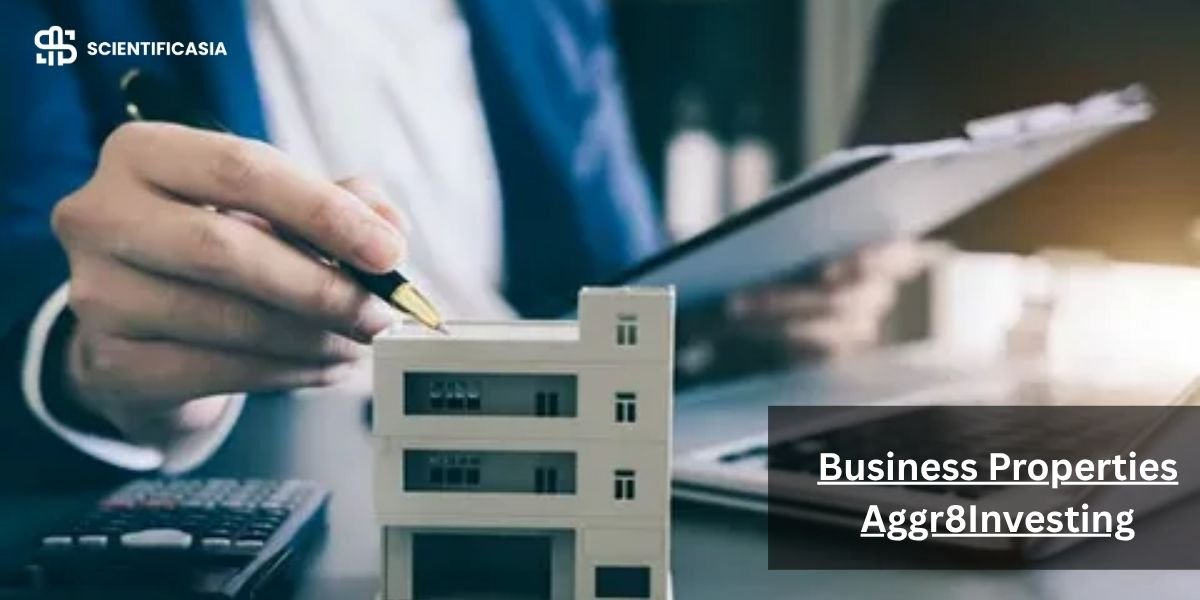Walking into commercial real estate (CRE) used to feel like entering an exclusive, walled garden. The price tags were huge, the secrets were held close by insiders, and you probably needed a few million dollars just to get a seat at the table.
But the world is changing. Today, smart technology and new investment models are tearing down those walls. This brings us to a strategy called Business Properties Aggr8Investing. It’s the modern way to own valuable commercial property—like warehouses and shopping centers—without taking on all the risk or the heavy management duties yourself.
It works by blending the solid wealth-building power of commercial property with the precision of data analytics and the safety of pooled investor capital. Whether you’re a beginner with a modest savings account or an experienced pro looking for better efficiency, this model is built for scalable, stable growth. Why shouldn’t your money work smarter, not just harder?
The Aggr8Investing Model: Why Smart Investors Choose Business Properties
So, what exactly is Business Properties Aggr8Investing?
Simply put, it’s a strategy for investing in income-producing commercial assets through a collective or “aggregate” approach. The “Aggr8” part means we pool the capital from many investors. This lets everyone buy a small piece of a much larger, higher-quality property—like a major logistics center or a necessity-based retail plaza—that one person couldn’t afford alone.
The real genius of this model is how it uses data. Traditional real estate often relies on gut feelings and old contacts. Aggr8Investing, however, uses smart algorithms and deep market data to find the best deals, forecast rental growth, and lower the chances of mistakes. It’s real estate investing built for the digital age, focused on getting you a long-term, stable return.
The Key Difference: Business Properties Aggr8Investing vs. Traditional CRE
| Feature | Traditional CRE Ownership | Aggr8Investing Model |
| Entry Capital | Very High (often $500k+ down) | Low to Moderate (fractional ownership) |
| Management | Completely Hands-On (tenant calls, repairs, leases) | Hands-Off (Managed by experts for a fee) |
| Diversification | Low (Usually 1–2 properties) | High (Multiple sectors & locations) |
| Transparency | Limited (Paper documents, private meetings) | High (Digital dashboards, regular reports) |
You see, traditional ownership is great if you have the time and the capital to do it all yourself. But for most people, the aggregated model is just a smarter path. It helps you avoid the biggest headaches and lets you start building wealth faster.
Value Proposition of Business Properties
The focus on business properties—also called commercial properties—is not by chance. These assets offer unique benefits that are hard to beat in other investment classes.
- Stable & Predictable Income: Businesses sign leases that last 5, 7, or even 10 years. Compare that to residential tenants, who might move out every year or two. This long commitment means your monthly income is far more reliable.
- Inflation Hedge: When inflation happens and prices rise, commercial properties tend to do very well. Why? Because most commercial leases include automatic annual rent escalations. This means your rent goes up with or slightly above inflation, protecting the value of your money.
- Tax Efficiency: This is a big one. Business property owners can use depreciation—a non-cash deduction—to offset their rental income, reducing the amount of tax they owe. For example, techniques like cost segregation can legally move these deductions up earlier, giving you huge tax savings in the first few years. You can also use a 1031 exchange to defer paying capital gains tax when you sell one property to buy a bigger one, which helps your wealth compound much faster.
- Portfolio Diversification: By pooling money, Aggr8Investing allows you to own pieces of several different types of properties—industrial, retail, office—all at once. This balancing act means if one type of property is having a bad year (maybe offices are slow), the other types (like booming warehouses) can cover the difference.
Strategy & Selection — How Aggr8Investing Identifies High-Yield Business Properties
The biggest secret to success isn’t just buying property; it’s buying the right property at the right time. This is where the data-driven strategy of Aggr8Investing shines. It replaces guesswork with deep analysis.
The analytical process looks at key factors like local job growth, which tells you how much demand there will be for office and retail space, and tenant stability, which protects your income.
Core Commercial Property Types in Business Properties Aggr8Investing
The strategy doesn’t chase every deal. It focuses on the strongest sectors:
- Industrial & Logistics: These are the backbone of e-commerce—warehouses, distribution centers, and fulfillment facilities. Demand here is incredibly high; they often require less management than offices, and the leases are typically long-term.
- Multifamily & Mixed-Use: While apartments are technically residential, large complexes are managed as commercial assets. They are highly scalable and famously resilient in downturns because people always need a place to live.
- Retail & NNN Properties: We’re not talking about struggling shopping malls. The focus is on recession-proof tenants—like a pharmacy, a quick-service restaurant, or a grocery-anchored neighborhood center. These are often structured as Triple Net (NNN) leases, where the tenant pays all taxes, insurance, and maintenance, making it a truly passive investment for you.
The Power of Data-Driven Property Selection
A key differentiator for a platform like Aggr8Investing is its ability to use market modeling with AI and predictive analytics. This means they aren’t just looking at what happened last year; they are using data to project what is likely to happen in the future.
This power allows them to spot off-market deals—properties that are not publicly listed. These might be buildings from owners nearing retirement, assets with simple management problems that scare away amateurs, or properties that are slightly distressed but have solid fundamentals. Finding these deals is often where the biggest profit is made, and data gives you a huge competitive edge.
Financial Metrics That Matter
If you want to sound like a pro in CRE, you need to know the basic numbers. Forget the complex jargon for a second. There are three key things to focus on:
- Net Operating Income (NOI): This is the single most important number. It’s the annual income the property makes after paying for all necessary running costs (like maintenance and property taxes), but before paying the mortgage. It’s the real performance indicator.
- Cap Rates: The Capitalization Rate tells you how much risk you’re taking for the return. You find it by dividing the NOI by the purchase price. A lower Cap Rate (say, 5%) usually means a safe, high-quality property in a downtown area. A higher Cap Rate (say, 8%) might mean a riskier property or one with more growth potential in a secondary city.
- DSCR (Debt Service Coverage Ratio): This shows a lender how easily the property’s income can cover the mortgage payment. Lenders typically want a DSCR of 1.25 or higher—meaning the property makes 25% more income than is needed to cover the debt.
Real-world sample calculation and sensitivity analysis: Let’s imagine a retail property bought for $5,000,000.
- Annual Rent (Gross Income): $450,000
- Annual Operating Expenses (Taxes, Insurance, Repairs, etc.): $100,000
- NOI: $450,000 – $100,000 = $350,000
- Cap Rate: $5,000,000$350,000 = 7.0%
A sensitivity analysis would then ask: “What if the rent dropped by 10%?” That simple question helps the Aggr8Investing team build a conservative and realistic financial plan.
The Practical Execution — Financing & Due Diligence for Business Properties Aggr8Investing
I think a lot of people get scared off here because the numbers are big. But the good news is you don’t have to do it alone. The business guide Aggr8Investing model is built to structure, fund, and secure deals that look huge on paper.
Financing Strategies for Scalable Growth
- Investor Syndication: This is the core of Aggr8Investing. You are a Limited Partner (LP), and your capital is pooled with others. This allows the group (led by the experienced Sponsor) to buy a $10 million property instead of just a $500,000 one. It’s pure scalability.
- Creative Financing: In tough credit markets, the best investors are creative. They might negotiate seller-financed loans, where the previous owner acts as the bank, or secure portfolio loans—financing multiple assets under one umbrella to get better terms.
- Tax Optimization: Remember those depreciation and 1031 exchange benefits? Using an expert CPA to structure the deal from day one is essential to make sure you get every legal tax advantage possible.
Essential Due Diligence for Business Properties Aggr8Investing
This is the part that protects your money. Skipping due diligence is the number one reason commercial deals fail. It’s like buying a car without checking the engine.
- Lease Review is Critical: Don’t just look at the rent amount. You must look at the fine print: rent escalations (when and how much rent goes up), the term length (how many years are left), and especially guarantees (is the tenant just a single small company, or a national chain with deep pockets?).
- Physical Inspections: You need a commercial inspector to check the big-ticket items: the roof, the HVAC (heating and cooling) systems, and the structure. A new roof can cost hundreds of thousands of dollars, so knowing its condition is a deal-breaker.
- Building Your Expert Team: You can’t do this alone. A specialized commercial broker helps you find the deal, and a great commercial real estate attorney structures the paperwork to protect your liability.
Long-Term Growth & Risk Mitigation
Success in real estate is really about avoiding big losses and letting the income stream run smoothly.
Asset Management for Passive Income
The word “passive” is key here. In an aggregated model, you pay professional management (usually 4–8% of the gross income) to handle everything. They collect rent, deal with maintenance, and manage the tenant relationship. For the passive income, this is the entire point.
Sometimes, the strategy involves value-add upgrades. This is where the managers buy a property that’s a little run-down, spend a bit on cosmetic renovations, or fix up the landscaping. This small investment boosts the curb appeal, allows them to raise the rents, and forces the property’s value higher before they sell it.
Understanding and Managing Key Risks
No investment is 100% safe, but smart investing is about managing the downside.
- Vacancy Risk: If a big tenant moves out, your income drops to zero. Mitigation with Aggr8Investing is through diversification. If you own small shares of five different properties in three different cities (industrial, retail, multifamily), one empty space won’t sink your entire portfolio.
- Liquidity Risk: It takes time to sell a commercial building. Mitigation is built into the investment plan. Most syndication deals have a clear exit strategy with a 5-to-7-year hold period. You know upfront when the property is likely to be sold and when you can expect your profits.
Avoiding Common Investment Pitfalls
I once heard an expert say, “You make your money when you buy, not when you sell.” That means avoiding expensive mistakes upfront:
- Overestimating Rents: Don’t just believe what the seller says. Verify actual rents with other similar properties.
- Undervaluing CapEx Reserves: Many investors are unprepared when the 20-year-old AC unit finally dies. Always budget 10–15% of your rental income for major repairs—your CapEx Reserve.
The Future of Business Properties — Technology, Data, and Aggr8Investing’s Edge
The biggest force shaping the future of real estate isn’t money; it’s data.
AI and predictive analytics are becoming standard for property sourcing. Artificial Intelligence can quickly scan millions of data points—everything from cellphone traffic to public spending patterns—to determine which micro-market is about to see a boom, long before a human broker notices. It’s a key reason why institutional money is flocking to platforms that prioritize data.
We are also seeing transparency improve dramatically. Organizations like JLL and Transparency International have shown that markets that embrace clear data and strict rules (like the US and UK) attract far more investment than those that are opaque. The best Aggr8Investing platforms lean into this, offering investors full digital dashboards that show every detail, from monthly rent collections to maintenance expenses, which is a huge boost to investor trust.
Comparing Business Properties Aggr8Investing with Other Platforms
You might be asking, “How is this different from a REIT?”
REITs (Real Estate Investment Trusts) are like stocks; they offer high liquidity, but their value often moves up and down with the stock market. Business Properties Aggr8Investing (through syndication) is an ownership model. You own a piece of a tangible asset, and the return is based on that property’s actual cash flow, not market sentiment. This difference is why beginners often prefer the stability and direct cash flow of the aggregated model for their first commercial exposure. It’s more about resilience and less about daily stock market swings.
FAQs About Business Properties and Aggr8Investing
Q: What is Business Properties Aggr8Investing?
A: It’s a modern investment strategy where many investors pool their money (aggregate) to buy large commercial real estate assets (business properties), using technology and data to manage them for stable, long-term returns.
Q: Is Aggr8Investing safe for beginners?
A: Yes, it is often a safer entry point than buying a property yourself. It gives you immediate diversification and relies on the professional expertise of the sponsor, which lowers your risk and removes the steep learning curve of property management.
Q: What are typical ROI expectations?
A: While returns always vary, similar real estate syndication models focusing on stabilized multifamily and industrial properties often target 7–8% annual cash-on-cash returns during the holding period, plus a large profit split when the property is sold (often resulting in an overall double-digit return).
Q: How much capital do I need to start?
A: Most reputable platforms have minimum investments, which can be as low as $5,000 to $25,000. This is what democratizes commercial real estate—you don’t need a massive down payment.
Q: How is this model different from REITs?
A: REITs are highly liquid and trade like stocks. Aggr8Investing is a direct ownership model, meaning your money is tied up for a set period (usually 5–7 years), but your returns are generally higher, you get better tax benefits, and they are less exposed to stock market volatility.
Conclusion & Next Steps — Building Wealth Through Business Properties with Aggr8Investing
The era of closed-off, complex commercial real estate is over. Business Properties Aggr8Investing represents a pivotal shift—it’s a path for ordinary investors to access sophisticated, income-generating assets.
This model combines the resilient, long-term cash flow of commercial properties with a highly disciplined, data-driven approach. It allows your investment to grow through predictable rents, tax advantages, and the sheer power of scale, all without you having to take a tenant’s call at 3 AM.
If your goal is to build wealth that is resilient to inflation and recession, then you must get your money out of low-yield savings and into tangible, income-producing assets.
Action Item: The first step is education and trust. Find an Aggr8Investing platform that prioritizes transparency—one that shows you the data, the expenses, and the projected returns clearly.
This video provides a deep dive into the full investment cycle of a syndication deal, which is the foundational structure of the Aggr8Investing model. You can see a real-world example of the process in this video:
Real Estate Syndication 101: Full Cycle Case Study
References
- Deloitte Insights. (2025). 2026 commercial real estate outlook: Data on recovery trajectory, AI adoption, and diversification. (Used for market trends and expert opinion on CRE outlook).
- Moody’s CRE. (2025). From Data to Decision: Data Analytics Will Drive Real Estate Transactions in the Future. (Used for insights on data science in CRE and predictive analytics).
- Rise48 Equity. (2025). A Peek Into The Projected Returns In A Real Estate Syndication. (Used for typical ROI expectations and hold periods in syndication).
- Excelsior Capital. (2025). The Ultimate Guide to Commercial Real Estate Investing: Key metrics, inflation hedge, and tax benefits. (Used for foundational CRE benefits and financial metrics).
- JLL. (2024). Highly transparent real estate markets make strong progress, outpacing peers. (Used for insights on technology, transparency, and global investment trends).














